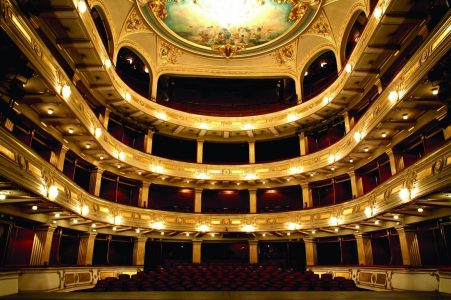From the technical point of view, the National theatre belongs to the best-equipped theatres, globally looking, with the top-notch equipment
In 1868, the year when the National Theatre in Belgrade was established, Serbia was populated with slightly more than 1,200,000 people and Belgrade had just over 25,000 inhabitants who lived in 3,444 houses. Belgrade was a big village, halfway between Ottoman and European civilization. Nonetheless, there was a need for the development of education, culture and science in a newly liberated country, as well as a striving to finish national liberation and uniting.

Attempts to establish a theatre were accompanied by attempts to find adequate building for it. In the meantime, performances were given either in the Customs office’s warehouse (Theatre on Djumruk), in hotels (Theatre Kod jelena), in the Prince’s Brewery, in inns (Kod krune and Kod engleske kraljice). A first substantial attempt to build the theatre was initiated by the Board of Supporters of National Education Association and the Theatre Board that organized fundraising.
Three years later, there was another unsuccessful attempt to build at the same lot. During winter 1867-68, Serbian National Theatre from Novi Sad gave sixty-four performances in inadequate premises in Kod Krune and Kod engleske kraljice inns in Belgrade. After one of these performances, Prince Mihailo said, “I am going to build you a theatre and you will be contented.”
First adjustments and extensions have been done as early as 1870. A relatively small stage required enlargement. The added part in the rear of the stage was lower and built of bad material. Besides the enlargement of the stage, there were plans to build changing rooms for extras, storage for décor and furniture, and a painting atelier. First plans for the extension of the building were elaborated probably by the contractor Vinter, but they were then again entrusted to Aleksandar Bugarski.
After one performances Prince Mihailo said, “I am going to build you a theatre and you will be contented”
In the summer of 1912, the enlargement of the stage started. However, in autumn of the same year, the reconstruction was stopped due to the start of the Balkan War, but it restarted in the summer of 1913 when the reconstruction was mostly finalized. The following year, 1914, reconstruction of the auditorium started, but the works were interrupted again due to the beginning of the First World War. In the period between 1915 and 1918, many elements of reconstruction were destroyed due to the bombing of Belgrade, as well as due to Austrian-German occupation.
Construction works on the Theatre continued in 1919, the plans of 1911 were somewhat changed, and the reconstruction finalized in 1922. In this reconstruction, the exterior architecture lost its unity of style and harmony of the original design by Bugarski; it became a mixture of secession and baroque. The auditorium now had 700 seats, 33 loges (plus a royal one, somewhat bigger than others) and 66 standing places – totalling to 944 places. The stage was enlarged in depth and a rotation around stage was installed.
The only thing that remained from the previous building was a medallion that represents a profile of Prince Mihailo, situated above the stage portal, renewed by sculptor Đoka Jovanović. The Theatre was damaged again in the bombing of Belgrade on 6th April 1941.
In 1986, the National Theatre and the City of Belgrade decided to start another, necessary extensive reconstruction of by then completely inapt building. The formal opening of the “new” theatre took place on 15 October 1989 and the first performance Aeschylus’ Oresteia was given on 10th November the same year. In this reconstruction, the old building restored its design from before the II World War and the total area got almost doubled by adding on the new modern construction where offices were situated on five floors above and two underground.
The building now has 18,500 square meters out of which 17,000 square meters are floor area. It can be said that the National Theatre in Belgrade today represents a modern unity of old and new in architecture, and from the technical point of view, the theatre belongs to the best-equipped theatres, globally looking, with top-notch equipment.
Written and organized by Jelica Stevanović
Texts written by Milica Jovanović, Aleksandar Radovanović, Mirjana Odavić were used